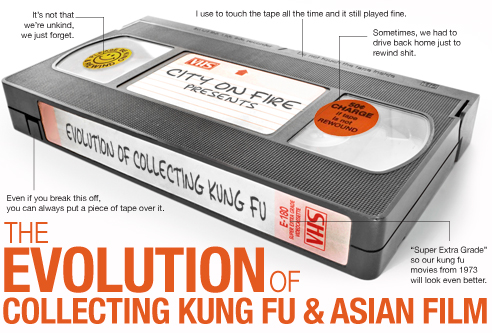 With the infinite amount of websites, eBay, and other online retailers; Asian/kung fu movie fanatics have it really good these days. Especially for the crowd who take advantage of bootlegs, DVD-R swapping and those sneaky forms of file sharing.
With the infinite amount of websites, eBay, and other online retailers; Asian/kung fu movie fanatics have it really good these days. Especially for the crowd who take advantage of bootlegs, DVD-R swapping and those sneaky forms of file sharing.
This wasn’t exactly the case in the 1980s and throughout most of the 1990s; back then, Asian movies were obtainable, but they weren’t a click away.
The Early-Mid 1980s: Rent it. Watch it. Record it.
I’m not old enough to have experienced the Grindhouse movie houses of the 1970s, but I can only imagine how awesome it was watching Five Fingers of Death in an actual theater. My first taste of the dubbed kung fu movie actually started in the early 1980s, when I was introduced to one in the form of a VHS cassette tape.
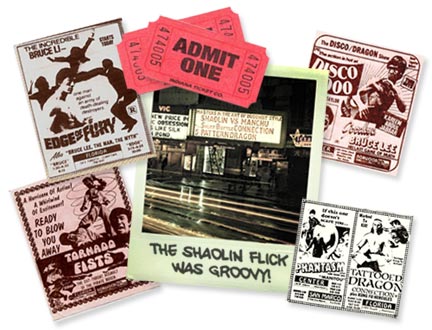
There was a time when you had to go to a theater to catch a kung fu flick. Watch out for sticky floors, because most-likely, a porno was playing the night before.
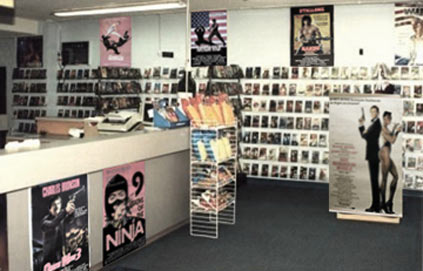
Now you can enjoy kung fu flicks in the comfort of your own home. Unfortunately, the days of “mom and pop” video rental stores like this are over.

The cheesier the logo, the better the movie.
It was the peak of the VCR (or Betamax, if you were a sucker) and my love for kung fu movies started to blossom. I had my share of renting movies from my local video rental store, then recording 4 or 5 movies onto 1 tape in EP mode. I absolutely loved walking into “mom and pop” video stores (90% of them were family owned in the 80s), mostly because there was always an extensive martial arts genre section, and every individual store always had certain titles that the others didn’t.
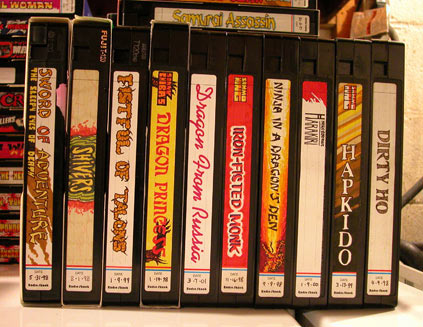
Artist Kung Fu Bob doesn’t mess around. His old collection consists of one movie per tape; back in the day, that was equivalent to Hi-Def 1080P. VHS labels never looked so cool.
My other option was recording Black Belt Theater (or Kung Fu Theater), a TV program that aired a different kung fu flick every Saturday afternoon. It was all about the anticipation, so it didn’t make a difference whether or not the movies were good; all that mattered was that it had funny dubbing, crazy sound effects and Asian guys fucking each other up.
It was a pain the ass to make sure you didn’t record the commercials, but that’s what the rewind button was for. Keep in mind, there was a time when VCRs didn’t have remote controls, so you literally had to get your ass up and run to the device to stop it.
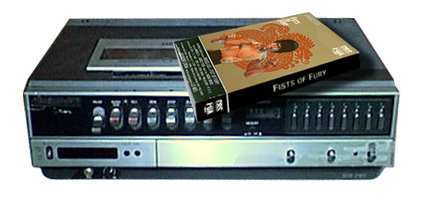
Don’t forget to adjust the tracking. As far as Laserdisc players? I never owned one. Not then. Not in the 1990s. Not ever. So, let’s pretend those don’t exist.
The Late 1980s/Early 1990s: High Prices and Bootlegs
We all slipped a Black Belt or Inside Kung Fu Magazine in our mom’s grocery shopping cart at one point in our lives. We never thoroughly read the damn things. We mostly just looked at the pictures and drooled over the ninja weapon advertisements – or – we browsed the the ads that were selling kung fu videos.
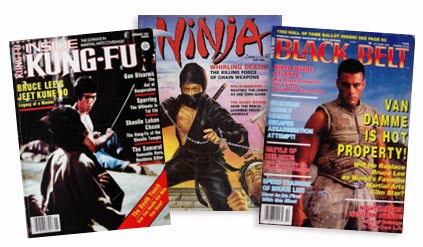
Inside Kung-Fu and Black Belt Magazines had cool advertisments in them. The Ninja Magazine always had a cool poster pull-out.
There were two video advertisements that always caught my attention:
Unique’s Action Video Library, which sold titles by “All Season’s Entertainment” (in really big Porn-like boxes). Basically, they were a collection of Jackie Chan’s pre-stardom Lo Wei produced/directed films, like Fearless Hyena, Dragon Fist, To Kill With Intrigue, Spiritual Kung Fu, etc. Each tape was $34.95 plus shipping & handling. The same company also offered the short-lived Cinema Group label (each box tagged “The Reel Thing”), which featured Golden Harvest titles, such as Dragon Lord, Police Force (aka Police story), Dreadnaught, Game of Death II, The Association and The Invincible Sword. These were a lot more expensive at $59.95 a pop, and $79.95 for Police Force — lucky for me, my local video store had this one for rent.
The other advertisement I remember was Dragon Video, a New York-based bootleg company (supposedly owned and operated by George Tan, the notorious Bruce Lee historian) which carried everything you normally couldn’t find in America: Chinese language versions of uncut Bruce Lee films, Shaw Brother films; as well as titles by Jackie Chan (Police Story II, Armor of God, Project A, Dragons Forever), Sammo Hung (Shanghai Express, Eastern Condors, Enter the Fat Dragon) and Cynthia Rothrock (Righting Wrongs, Magic Crystal). They had everything you wanted for about $34.95 a tape. It’s important to keep in mind that this was the late 1980s/early 1990s, so a lot of these titles weren’t legitimately available until years later. As long as you could put up with sketchy PAL transfers, grainy video quality and cut-off subtitles, this place was a dream come true.
Depending on where you lived, you could have probably found these titles at your local Chinatown or Chinese video rental stores. However, it was a hit or miss when it came to knowing if they had English subtitles or not. More importantly, I’m a non-Chinese, so it was always interesting to see how the clerks reacted to my presence. They would get nervous and most of them wouldn’t even want to deal with me. I’ve been there, trust me. It’s a good thing I had a lot of Chinese friends.
Footnote about Dragon Video: When I was a kid I used to call my orders in (remember CODs?), that way I wouldn’t have to wait an extra week for my payment to get there. To make a long story short, whoever was answering the phone was an asshole. They basically acted like you were bothering them every time you made a purchase, and they always took me for an idiot and tried to sell me the lamest titles: “You should get Killer Meteors. It’s one of Jackie Chan’s best. It’s the only film where he fights Wang Yu. A must have. You want it? No? You’re dumb. You don’t know what you’re talking about, kid!”…
By the way, don’t ask me where I got all my money to order these tapes. That’s a whole other story. Damn, I was a horrible kid.
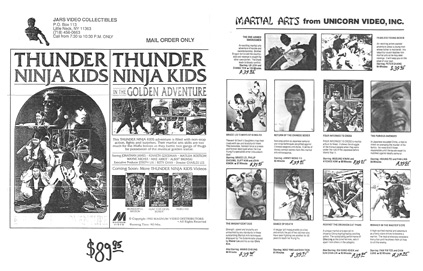
Jars Video Collectibles advertised in many martial arts magazines as well; they also did direct mail pieces like this. Note the very high prices for some lesser known movies from Unicorn Video, Inc. and Magnum.
Another option was if you walked into your local Kmart or drugstore, you always had the option of picking up titles put out by low-budget companies like Goodtimes Home Video, Video Treasures and Best Film Co., who were notorious for putting out various Bruce Li and Bruce Le movies like Bruce vs. Bill and Legend of Bruce Lee. These usually went for about $6-$9 per tape, and they were always recorded in EP, so the quality would be worse than bad.
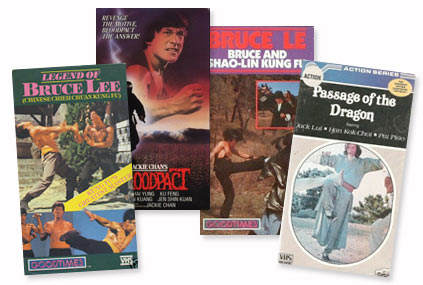
What did Kmart, Savon and Walgreens have in common? They all carried these bullshit EP-mode titles. Don
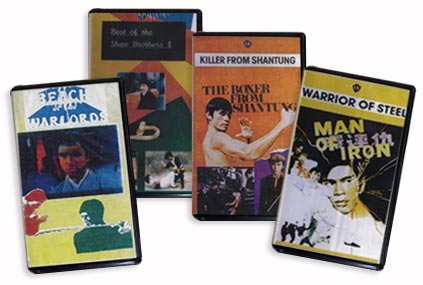
VHS Bootlegs often come in clam shell plastic cases, with xeroxed paper inserts of ameteur designs. At the time, this was the only way to watch some of these classics.
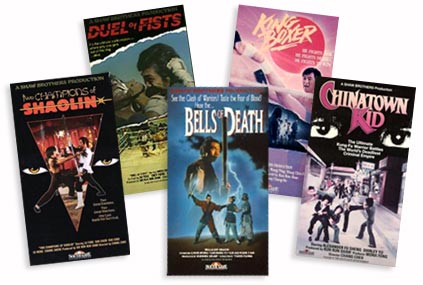
Southgate, Forum, and Vista were some of the few companies that released legitimate Shaw Brothers titles in the 1980s. Warner Bros. and 20th Century Fox also bought rights to a few films, such as Seven Blows of the Dragon.
The Late 1990s/Early 2000s: U.S. Release of Rumble in the Bronx changes everything.
While watching the 1995 MTV Movie Awards, something unexpected happened that would change everything: Jackie Chan was honored with a MTV Lifetime Achievement Award (which was presented by Quentin Tarantino, hot off his Pulp Fiction success), and viewers were treated to film clips featuring his breathtaking stunts and martial arts skill. All-of-the-sudden, Jackie Chan was the talk of the town. A few months later, Rumble in the Bronx was released theatrically, and before you knew it, Jackie Chan was everywhere.
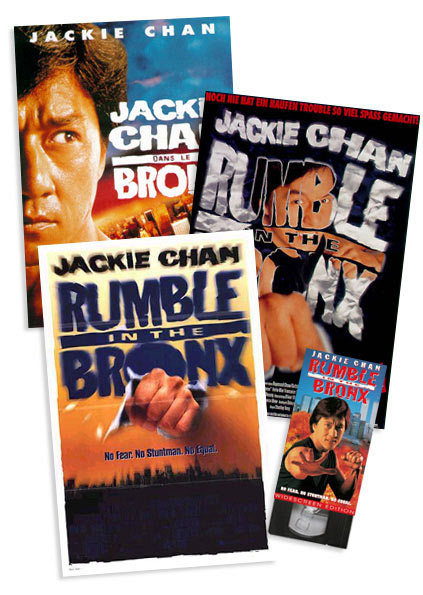
After failed attempts with The Big Brawl (1980) and The Protector (1985), Jackie Chan finally did it his way with 1995’s Rumble in the Bronx. From this point on, Van Damme and Seagal were looked down upon, and the first Asian star (since Bruce Lee), takes America by storm.
Exploitative video companies like Simitar and Xenon decided to cash in on the Jackie Chan phenomenon, so they began to release obscure (and very awful) Jackie Chan films like 1973’s Police Woman (re-titled to Rumble in Hong Kong). More titles followed, mostly with ‘new’ images of him sporting his black tank top from Rumble in the Bronx, which are then slapped on to older movies boxes to fool people into thinking they were fairly new titles. They even started putting his name and image on films like Pink Force Commando (re-titled to Jackie Chan’s Crime Force), a 1982 film that he doesn’t even appear in.
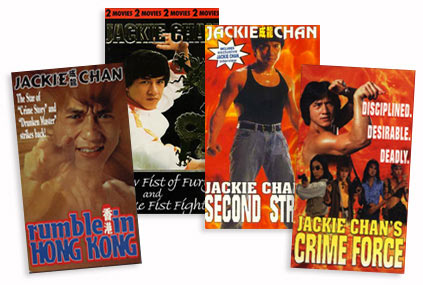
Low budget companies like Simitar and Xenon packaged older Jackie Chan movies to make them look like recent hits.
This exploitative practice was actually nothing new. After Bruce Lee’s death in 1973, greedy movie producers started churning out Bruce Lee imposter movies (aka Bruceploitation) with names like Bruce Li, Bruce Le, Dragon Lee and Bruce Lai. The films were titled using combinations of the words “Dragon”, “Fury”, “Boss”, “Enter”, “Game” and “Fists” (ie Enter Three Dragons, Big Boss of Hong Kong, Edge of Fury, The Iron Dragon Strikes Back), to mesh with with Bruce Lee’s real films: Fists of Fury, The Big Boss, Way of the Dragon, Enter the Dragon and Game of Death.
Similar situations happened when both John Woo and Chow Yun Fat gained popularity in Hollywood with hit films like Face/Off, Replacement Killers and The Corruptor — again, third rate companies got their slimy hands on their older, below average films, and they were re-titled Hong Kong Face-Off, Hong Kong Corruptor, etc.
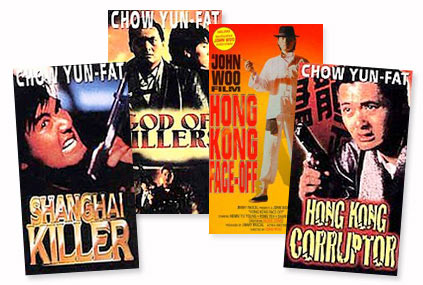
Xenon is at it again, this time using any words that contain Killer, Face-Off or Corruptor on 3rd rate films from John Woo and Chow Yun Fat’s early years.
Another company called Tai Seng has been importing legit Chinese releases for years; Oddly, they would sell titles that would be spread out on 2 VHS tapes, even though they could have easily fit the film on a single cassette. Maybe they thought that justified their expensive price tag of about $60 per double tape.
During the “Rumble in the Bronx” era, Tai Seng finally started releasing dubbed versions of Jackie Chan movies like Young Master, Heart of Dragon and Wheels on Meals; not to mention other popular titles like Untold Story, Zu: Warriors from the Magic Mountain and Organized Crime and Triad Bureau – at about $20 a tape, I say Tai Seng redeemed themselves.
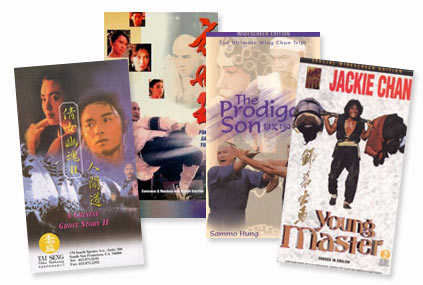
Tai Seng was one of the few legitimate importers for Chinese films; however, they thought it was funny to sell us a 90 minute movie on two VHS tapes for over $70. They redeemed themselves in the late 90’s when they started to release widescreen, dubbed versions of films like The Prodigal Son and Young Master.
Somewhere between 1996 and 1998, the Internet became one of the biggest spectacles since radio and TV — hence advertising, hence retail, hence “I can now order anything from anywhere at any time…”
You want to see what else Michelle Yoeh did before she was a Bond girl in Tomorrow Never Dies? You want to purchase more of Jet Li’s movies after seeing him kick ass in Lethal Weapon 4? You want to see more of Yuen Woo-ping’s work after watching The Matrix? Go on to the internet, do some research, and order some shit.
During the late 90s, the DVD (Digital Video Disc) Player emerged and within a couple of years, the new format replaced the VCR (and whatever was left of the Laserdisc). With multi-language tracks, subtitle options, super clear picture quality and compact disc size; it became one of the most satisfying pieces of technology, convincing Asian film fanatics that their possibilities of film choices are limitless.
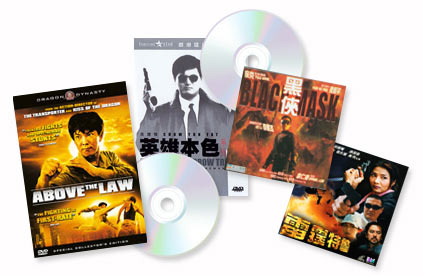
Video killed the radio star. But video’s kung fu was no match for the digital discs.
DVD players also play VCDs (Video Compact Discs), which was a format very popular in all of Asia (with the exception of Japan). The bad thing about VCDs is that the movies were usually spread out on two discs, picture quality was blocky due to poor video compression; in fact, they were probably worse quality than VHS tapes. The good thing about VCDs was they were ultra cheap (usually about $5 a pop) and there were a lot of titles to choose from – and bootlegs were EVERYWHERE.
There is a slight downside to buying import DVDs. Every once in a while you’ll run into a Region coding problem, but it can easily be fixed with a $50 All Region DVD player. If you’re lucky, you may able to hack your current one – it’s as simple as typing your model number onto a google search.
2000-Current: It’s a small world after all…
Since then, Asian film culture in America has multiplied; and it’s not just Chinese films, it’s Japanese, Thai, Vietnamese and Korean filmmakers as well. They’ve all pumped out their share of memorable titles and undisputed classics. Many have been re-released (Legend of the Drunken Master, Sympathy For Lady Vengeance, Zatoichi), some have been re-made (The Departed, The Grudge, The Ring) and a lot of them have simply influenced Hollywood’s most creative talents (Quentin Tarantino’s Kill Bill Vol. 1 and 2; Wachowski Bros.’ The Matrix Trilogy).
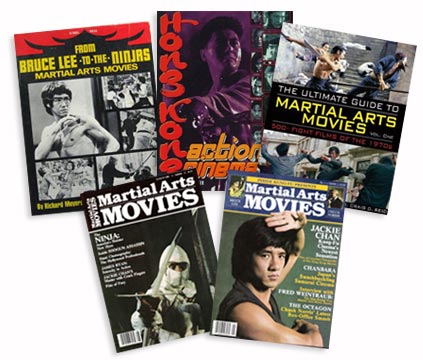
The many books and magazines dedicated to Kong Kong and martial arts film. The market for martial arts film is still going strong.
Whether you’re watching them, buying them, or even just reading about them; Asian film is a hard subject to keep up with. Hong Kong companies like Universe, Joy Sales, IVL and Mega Star are not only releasing current titles every day, but old ones as well; with more new features, improved image and sound quality.
Even U.S.-based companies, like Well Go USA, Image, FUNimation, Discotek Media, Vivendi (Dragon Dynasty), Tokyo Shock, Kino, Criterion, Magnolia, and First Look; all released everything from Shaw Brothers titles (from the same Celestial masters the HK editions use) to just about every popular Asian movie out there. Even some of the heavies like Columbia/Tri-Star and Fox have had their wave of releasing numerous favorites – new and old.
Since the average kung fu title isn’t as demanding as say a more mainstream title like Crouching Tiger, Hidden Dragon, expect many out-of-print issues with all these companies, but nothing that can’t be solved by visiting ebay or amazon.com, where you can find new and used copies of DVDs that are no longer in circulation.
Of course, every era has its “Dragon Video”. With today’s computer technology, graphic design software, and commercial DVD duplication machines, you bet your ass bootleggers are running more rampant than ever before. Unlike the VHS days, there’s no decline in picture quality since every byte is getting transferred flawlessly.
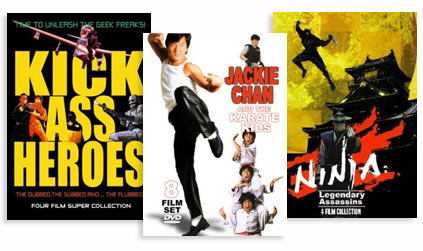
Companies like VideoAsia are following the footsteps of Xenon by exploiting popular films like Kick-Ass (Kick Ass Heroes), Jackie Chan
Gone are the days of having to mail-order bulky VHS tapes of your favorite Asian films, and waiting “4-6 weeks” for their arrival. Now you can walk into a retail store – or better yet – find more of them online with the quick delivery of today’s parcel services. As far as super-rare titles go, just visit a Asian film forum, make some friends, and they next thing you know, you’ll have DVD-R copies of these titles for a few bucks — or trade. There’s also the option of downloading torrents (which I’m not condoning, but sometimes it’s the only way) or even watching what you can on youtube, which offers endless rare clips and trailers.
But let’s not get too excited just yet…
There are still countless titles that haven’t seen the light of day since their VHS or theatrical release dates. Take for instance, The Big Boss Part II (not to be confused with anything you’ll find on the net, trust me…), starring Lo Lieh and Bruce Le; or even some of the current alternate cuts of existing films, like Bruce Lee’s infamous saw-in-the-head scene from the original The Big Boss. Even if some of these films do turn up, there’s always the same issues: Is it widescreen? Is it cut? Was it cropped? How’s the quality? Is it dubbed? Are the subtitled legible? Of course you always get that one guy who ‘owns it’. Maybe he does, maybe he doesn’t? If he does, it’s ashame that we may never see it, due to pride or greed issues. Bastards. What’s even worse is the fact that many of these movies are sitting somewhere collecting dust in some basement. Just ask Bey Logan (Hong Kong film historian), if it wasn’t for this guy roaming around the gritty film archives of Golden Harvest’s backrooms, that raw Game of Death ’73 footage would still be shit mats for rodents.
For the most part, the best of the best is obtainable.
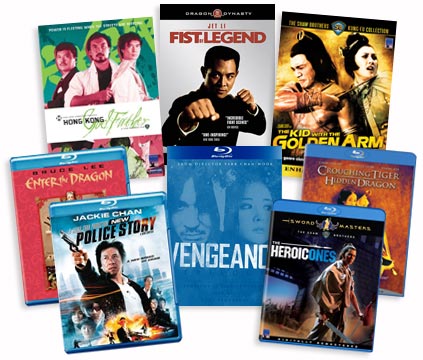
Welcome to the future.
We now have High Definition TVs, Blu-ray players, and updated 3D technology; it’ll be interesting to see where this all takes us. LCD and LED TVs will probably continue to get bigger and thinner; but bersonally, I think we hit a brick wall. Currently, the modern TV displays are a lot clearer than my eyes can handle. As far as this new wave of 3D, I could give a shit about it. It’s a cool novelty for about 10 seconds, but as a whole it adds nothing to the experience of what a good movie is all about.
So, what’s next? See you in 30 years… (if you don’t want to wait 30 years, click here to read Part II of this article).
Special thanks to Dan Jackson, ThunderScore, Kung Fu Bob and CoolAssCinema.com for supplying me with videotape artwork and magazine covers and advertisement scans.

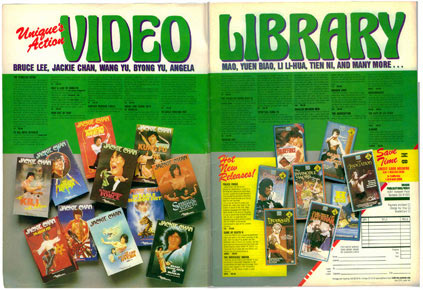
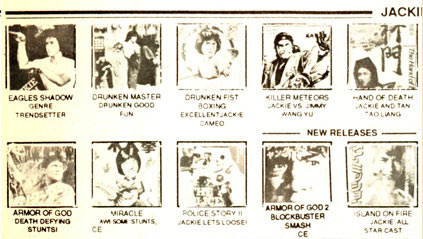
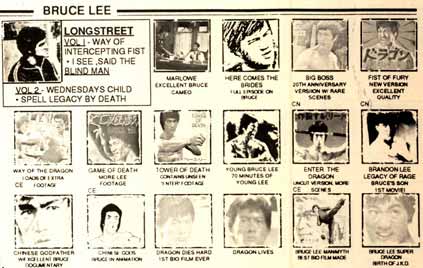
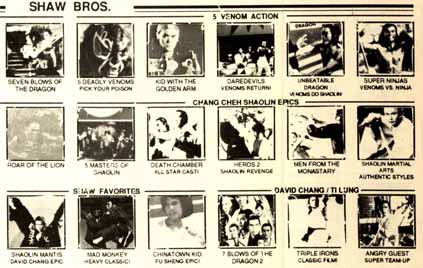


Your article brings back memories and tells it like it was! I did see a lot of flicks at grind house theatres in Chicago! Some of my fondest memories! 5 Fingers Of Death, The Chinese Connection, Enter The Dragon, The Chinese Proffesionals, Chinese Hercules, and many others were burned into my brain from the big screen in the balcony!
Bringing back memories was definitely my intention. =D In a way, I wish I were a little older, that way I could have been a part of the ‘grindhouse’ theatres. Thanks for reading!
Great article! It took me back, and it made me laugh. And seriously, I never get sick of VHS covers. Well done.
Thanks Ninja Squid!
It was a lot of fun writing it! I checked out your blog… man, you can’t really blame those people for not ‘getting’ those old school shaw flicks. I’m sure teenage girls would be doing the same to us if we laughed at any of their Twilight movies… if that makes any sense. =D
Awesome retrospective. Still go to a mom and pop video store in my town, but it’s sheel of what it used to be sadly, they have a very small Martial Arts section, the rest they just put into the Action section, if the joint ever closes up, I’m gonna deplete my bank account.
Fabio: Thanks for reading. I miss those good old days too. Fortunately, I’m at the age where I experienced all of it. That makes me happy enough. =D
Very good article! Takes me back to the 1980’s when I was a martial arts movie nut! Always looking for ninja movies!
I was always looking for ninja movies, as well. Other than the Canon/MGM flicks, the ninja movies I found were all wack! I made the mistake of renting stuff like NINJA THE PROTECTOR many times. lol
incroyable article, merci bien.
Can Me Help To Find Enter The Ninja New Sealed 1983 Large Box VHS VHS Release Date: December 1983 US MGM/UA Home Video 1983 Large Box VHS MV700186 & Revenge of The Ninja New Sealed 1984 Large Box VHS VHS Release Date: September 14, 1984 US MGM/UA Home Video 1984 Large Box VHS MV800329 & Ninja III: The Domination New Sealed 1985 Large Box VHS VHS Release Date: April 1, 1985 US MGM/UA Home Video 1985 Large Box VHS MV800546